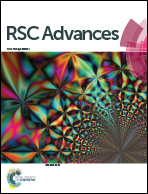Study of the modification mechanism of heavy metal ions adsorbed by biomass-activated carbon doped with a solid nitrogen source†
Abstract
In this study, the N-doping of biomass-activated carbon with dicyandiamide was performed via an ultrasonic method and a redox method. BET, SEM, EDS, FT-IR and XPS were used to determine the pore structures, morphologies and surface chemistry of the adsorbents obtained. The N-doping effect of the two modification methods on the same solid nitrogen source was evaluated and the simulated adsorption experiments of heavy metal ions in wastewater were conducted. The results showed that the N-doped biomass-activated carbon having the higher doping content was obtained by a redox method with nitric acid at 25 °C, a solid nitrogen source ratio of 1 : 1 and charring at 800 °C for 2 hours. The adsorption efficiency for the divalent copper ion of the sample obtained by the redox method was 41.15% higher than that of the ultrasonic method sample, and proved that pyridinium nitrogens and amino groups play important roles in adsorption and complexation processes. The isothermal adsorption experiments of N-doped activated carbon conformed to the Freundlich model, which mainly depended on chemical adsorption. The kinetics for copper ion adsorption followed a pseudo-second-order kinetic model. Thermodynamic experiments showed that a higher temperature was advantageous to adsorption. Simultaneously, this study further analyzed the N-doping process of the redox method sample and suggested that improvements can be implemented in the N-doping of activated carbon with solid nitrogen sources.



 Please wait while we load your content...
Please wait while we load your content...